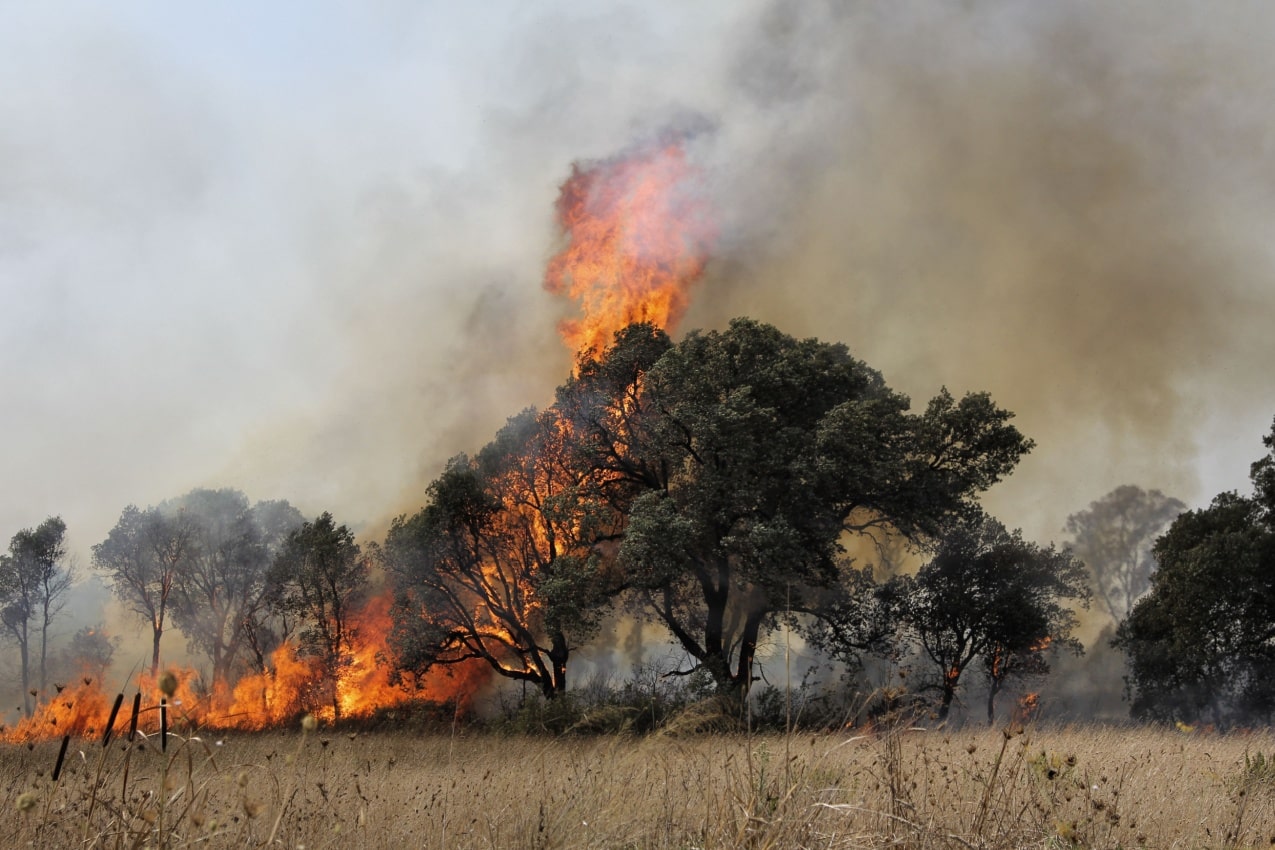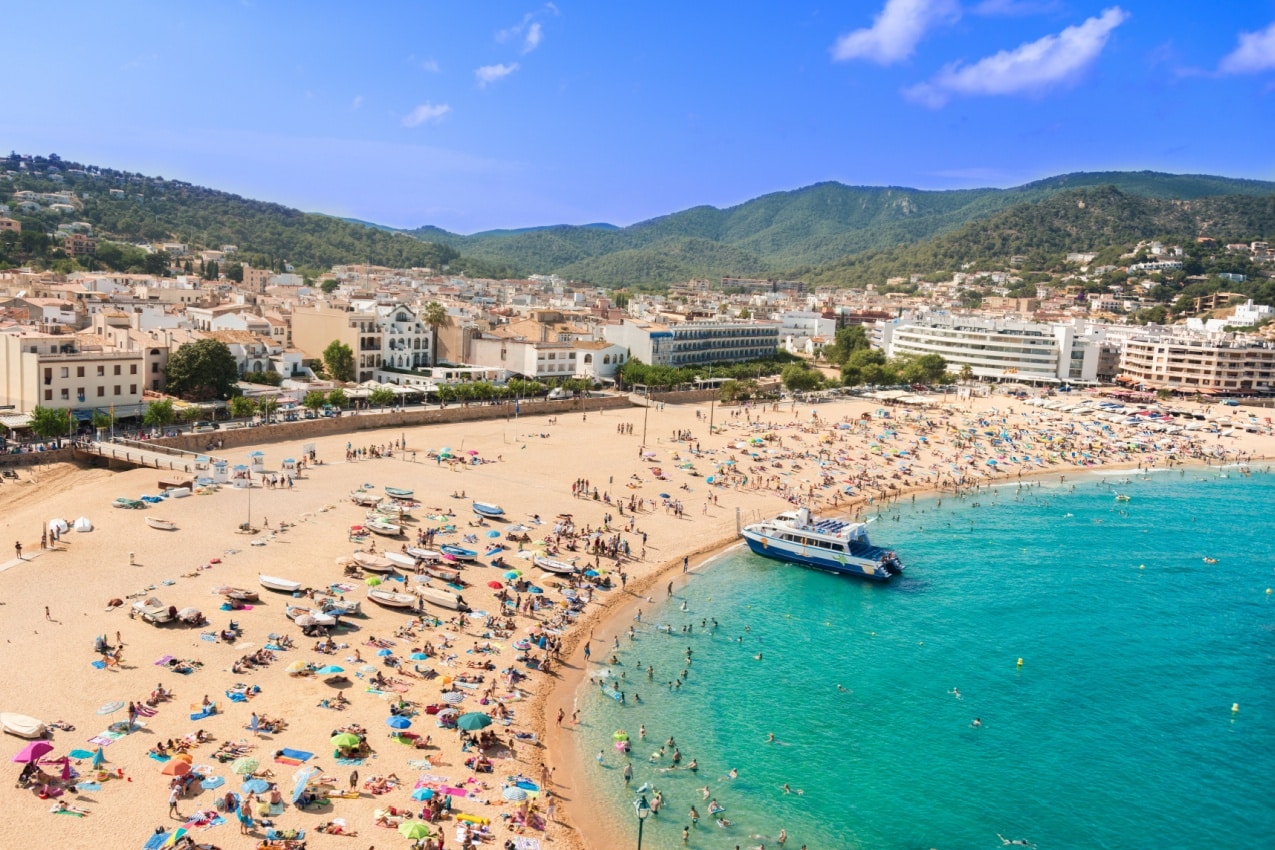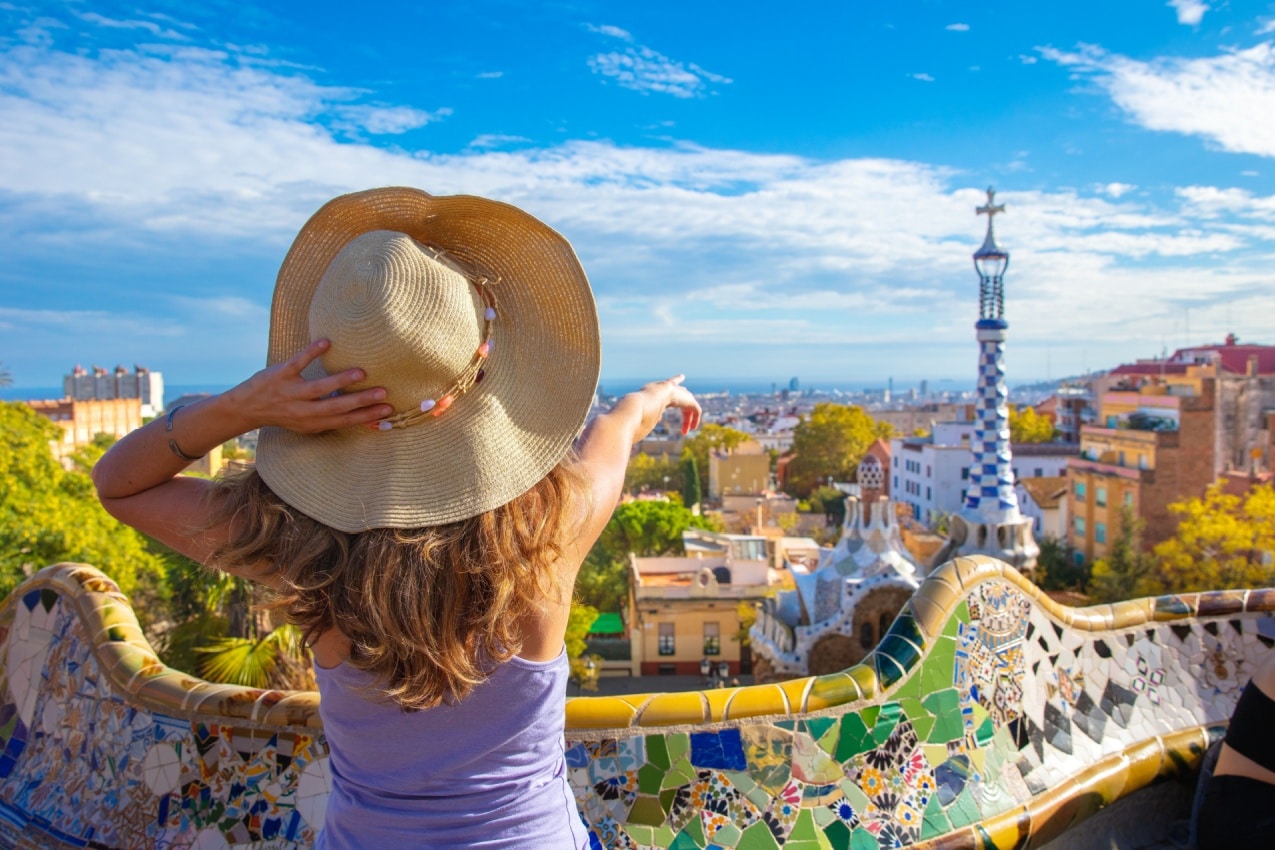Spain is the second most-visited and the 32nd safest country in the world. Despite that, in the middle of the tourist hustle and bustle, a bit of petty crime does happen.
As such, the US travel advisory recommends being a bit more cautious than usual here. It’s nothing to lose sleep over, though! You just need to be informed so you know what to expect—so let’s jump right in.
Is Spain Safe?

Spain is generally a safe place to visit, according to trustworthy sources.
According to CNN, Spain is one of the top countries for expats, and when a place is good for residents, it’s bound to be safe for tourists too.
InterNations’ 2023 rankings crowned Málaga, Valencia, and Alicante as some of the best places for living the good life, whether it’s for their friendliness, healthcare, or affordability. Other honorable mentions on the list include Madrid and Barcelona, always bustling with culture and life.
Spain is also one of the most LGBTQ+-friendly countries out there, with same-sex marriage legalized back in 2005. The epic pride celebrations draw millions of people every year, showing just how progressive and accepting Spain really is.
Forbes’ 2022 list also mentioned Spain as one of the safest places to visit.
The potential risks to be aware of? Pickpockets in public places, political demonstrations in the area of Catalonia, (very rare) extremist threats in the major cities, and overindulging in alcohol and illegal substances in party places like Ibiza.
Here’s the safety scoop:
- International travel advisories: Level 2, Exercise Increased Caution
- Crime rating: 36.25
- Most common crime: Theft
- Most high-crime places: Balearic Islands, Catalonia, Madrid
- Public transportation safety: Watch out for pickpockets, otherwise, it’s safe and on time
- Road safety: Driving is generally safe, roads are well-maintained with clear signage
- Safety walking alone during the day: Safe
- Safety walking alone during the night: Moderately safe
- Beach safety: Safe and secure, complete with nearby showers, good accessibility, and lifeguard services
- Common natural disasters: Storms, wildfires, earthquakes, and tornadoes
- Carbon monoxide poisoning: No reported incidents involving tourists, but the threat persists
- Police presence: Mostly present around tourist hotspots, malls, clubs, and during big events and holidays
- Medical care quality: Good healthcare and plenty of respectable hospitals
Travel Advisory for Spain
The U.S. State Department has given Spain a level-2 travel warning: Practice Increased Caution.
“The tourism industry is generally well-regulated, and protocols [concerning safety inspections and best practices] are routinely upheld,” according to the U.S. State Department.
The caution, however, stems from concerns regarding crime, political protests, and terrorism.
“Pickpocketing and other minor crimes, such as theft, are very common in Spain,” warns the U.S. State Department. Travelers are advised to keep their passports secure and avoid leaving bags unattended.
The U.S. State Department shares that demonstrations can pop up in Spain over political or economic issues, during big holidays, or when there are international events, and advises travelers to “check local media for updates and traffic advisories.”
The advisory points out the country’s open borders with neighboring European countries and its enclaves in Melilla and Ceuta as potential entry points for terrorist groups. While Spain has taken strong measures to prevent terrorist attacks, tourists should remain vigilant and aware of their surroundings at all times.
A Comprehensive Look at Spain Crime Rates
Spain has a pretty low crime rating of 36.25.
In 2021, there were around 1,960,113 reported crimes across the whole country. That works out to about 41.4 incidents per one thousand people. It’s the lowest it’s been in recent years, except for 2020 because of COVID-19.
The most common crime in 2022 was theft, with 24,462 reported cases—a drop from about 26,500 in 2019.
The Balearic Islands had the highest crime rate in 2022, with 64 crimes per 1,000 inhabitants. Catalonia came next with 61, and Madrid with 59. Among the islands, Ibiza had the highest crime rate at 79 per 1,000, followed by Mallorca (64), Formentera (55), and Minorca (42).
All things considered, the regions with higher tourist traffic tend to experience more crime. However, Spain remains a safe destination. Just keep an eye on your stuff, like you would anywhere else, and you should be fine.
| Safety Concerns | Crime Rate | Status |
| Overall Crime Level | 34.83 | Low |
| Crime Increasing in the Past 3 Years | 60.06 | High |
| Home Break-Ins and Thefts | 34.31 | Low |
| Mugging and Robbery | 37.26 | Low |
| Car Theft | 26.63 | Low |
| Theft from Vehicles | 38.37 | Low |
| Personal Attacks | 32.06 | Low |
| Verbal Insults | 32.01 | Low |
| Racial, Ethnic, Gender, or Religious-Based Attacks | 20.62 | Low |
| Drug Use and Dealing | 46.55 | Moderate |
| Property Crimes (Vandalism and Theft) | 43.29 | Moderate |
| Violent Crimes (Assault and Armed Robbery) | 30.38 | Low |
| Corruption and Bribery | 48.60 | Moderate |
| Safety Walking Alone in Daylight | 79.63 | Safe |
| Safety Walking Alone at Nighttime | 58.83 | Moderate |
Source: Numbeo, 2024 data based on 4,154 contributors.
Personal Crime in Spain
According to Numbeo, personal crimes are pretty uncommon in Spain, so you’re unlikely to run into any trouble during your trip.
Solo female travelers might get some wolf-whistling or cat-calling, but overall, locals are respectful and don’t bother tourists in such a manner.
Falling victim to personal crime depends on where you are, what time of day it is, and how you’re behaving. For instance, if you’re out late and acting rowdy after drinking too much, you might get into trouble. But showing respect wherever you go is just common sense, not just in Spain.
Overall, Numbeo says it’s safe to walk alone during the day in Spain. But like anywhere else, it’s wise to stay alert at night. After dark, Spain is rated as “moderately safe.” This is because nightlife brings its own set of concerns like drunk people and rowdy behavior. Not to mention that while crime in broad daylight is more common by a small margin, violent crime usually occurs at night.
Property Crime in Spain
Theft is a common concern in Spain.
Often, visitors are so engrossed in sightseeing and snapping photos that they overlook their surroundings—and since tourists tend to carry more cash and valuables, they are the prime targets of theft.
Be extremely cautious when traveling in crowded buses and trains, enjoying your meal or drink at a café or bar, sunbathing at the beach, or sightseeing at museums or popular cultural sites—these are the main hit points for theft.
Beware of fake police officers too. Some pose as authorities and ask to inspect your wallet for identification only to swipe your cards or cash. Always them to show you proper identification if approached, as genuine officers typically won’t stop you unless there’s a valid reason.
Stay alert even in your hotel lobby. When checking in, keep an eye on your luggage and belongings. Don’t leave them unattended in the lobby, as pickpockets seize the chance to snatch valuables when you’re distracted.
Police Presence in Spain
Spain has plenty of police officers keeping a watchful eye.
You’ll see plenty of them if you’re hitting the clubs—likely checking for anything illegal or dangerous among the partygoers. You’ll also notice more police out and about around big holidays like Christmas, especially around shopping spots.
During the tourist season, Spain also runs “Operation Safe Summer.” This is when the Spanish Government brings in cops from other countries to help out in tourist areas.
In 2023, Operation Safe Summer brought French and Italian officers in Alicante and Benidorm, and Italian and German officers in Ibiza’s Santa Eularia.
The policemen you’ll come across will likely be friendly and easy to approach. Just remember to show respect and follow the rules. That way, you can relax and enjoy your time in Spain, knowing you’re well taken care of.
Public Transportation Safety in Spain

Public transportation in Spain is generally safe and convenient.
Madrid, for example—boasts one of the world’s top 10 metro systems, right up there with cities like New York, Paris, and London. But it’s not just Madrid; cities across Spain, like Barcelona, Seville, Valencia, and more, have efficient bus, tram, and metro networks too.
Taxis are generally safe, plentiful, and regulated. Some taxi stands even display fares for popular destinations so you know what to expect. You can also use ride-sharing services like Uber or Cabify.
If there’s no meter, make sure to agree on the fare before starting your journey. If you’re not fluent in Spanish, it’s a good idea to write down your destination to avoid any misunderstandings.
Keep an eye out for illegal taxis that may try to take advantage of tourists! If you feel like you’ve been overcharged, ask for an official receipt and report the issue to the local authorities.
Road Safety in Spain
Driving in Spain is usually safe, with well-maintained roads and clear signs all over.
Here are some important things to keep in mind, especially if you’re not from Spain:
- You must be at least 18 years old to drive in Spain and 21 to rent a car.
- The legal blood alcohol limit for driving in Spain is 0.5 g/l in the bloodstream (or 0.25 mg/l in exhaled air).
- The speed limit on highways is 120 km/h (75 mph), 100 km/h (62 mph) on main roads or roads with two lanes, 90 km/h (56 mph) on all other roads, and 50 km/h (31 mph) in urban areas such as cities, towns, and villages.
- Some roads here can be twisty and hilly, so take it easy. Always be on the lookout for other drivers making sudden moves.
- Keep an eye out for mopeds and scooters, especially in places like Ibiza where they’re popular modes of transportation.
Medical Care Quality in Spain
Spain’s healthcare system is good, ranking 21st overall in the 2022 World Index of Healthcare Innovation.
Here are some of the best hospitals you’ll find in Spain:
- Hospital Universitario La Paz, Madrid
- Hospital Universitario Fundación Jiménez Díaz, Madrid
- Hospital Clínico San Carlos, Madrid
- Hospital Universitario 12 de Octubre, Madrid
- Hospital General Universitario Gregorio Marañón, Madrid
- Hospital Ramón y Cajal, Madrid
- Hospital Universitari Vall d’Hebron, Barcelona
- Hospital Clínic de Barcelona, Barcelona
- Hospital Universitario y Politécnico la Fe, Valencia
- Clinica Universidad de Navarra, Pamplona/Iruña
If you’re an EU/ EFTA (European Free Trade Association – Iceland, Liechtenstein, Norway, and Switzerland) resident, you’re in luck—public hospitals provide free treatment with your European Health Insurance Card. However, for private medical services, you’ll need to pay out of pocket.
If you don’t have a European Health Insurance Card or wish to get private treatment, invest in medical travel insurance. That way, you’ll be covered for any unexpected medical expenses.
And don’t worry if you need a pharmacy after hours—there are 24-hour pharmacies. Just remember, for regular medicine, head to a “Farmacia,” not a “Parafarmacia,” which sells herbal remedies.
Is It Safe to Travel Solo in Spain?
Spain is a great destination for solo travelers, and here’s why.
Firstly, the locals are known for their friendliness and helpfulness, especially in cities like Malaga, which is considered one of the friendliest cities in the world.
And with Spain being a hotspot for tourists, you’ll never feel lonely. There are millions of travelers around, so you’re sure to meet people to hang out with and share your adventures.
You can also join group tours to explore safely. From visiting iconic landmarks like the Alhambra and Sagrada Familia to enjoying food tours and hiking adventures, there’s no shortage of options to keep you entertained.
As always, stay mindful of your surroundings. Remember to:
- Keep your belongings close
- Stick to well-lit areas at night
- Watch your drinks
- Ignore catcallers, especially for solo female travelers
- Be cautious about sharing personal info, like where you’re staying
Perils of Nature: The Risk of Natural Disasters in Spain

Spain is generally lucky to have a low risk of natural disasters.
However, when Mother Nature does decide to make an appearance, it comes in the form of severe storms, wildfires, earthquakes, and tsunamis.
Storms
Storms almost never happen during the peak summer months when most tourists flock to the country.
Instead, rainy days are more common from mid-autumn through to spring—and some of them can pack quite a punch. In October 2023, Storm Bernard hit Southern Spain, causing some serious damage and sadly, casualties. And back in 2019, there was a wild tornado along the coast of Ibiza that left a few people injured.
Thankfully, we’ve got modern weather reports to help us stay on top of things. So for more information about upcoming storms, visit the State Meteorological Agency (AEMET), or download the El Tiempo de AEMET app.
Wildfires
Wildfires are most likely to occur during the hot summer months, but they can happen at other times too, especially after long stretches of dry and scorching weather.
In the summer of 2023, Ibiza was at “extreme” risk, but luckily, no fires broke out on the island. However, in the fall of the same year, a wildfire in eastern Spain forced 850 people to evacuate.
The least you can do to prevent such tragedies is to not light a fire in mountains, forests, or rural areas in Spain—especially between May and October. If you ever spot a forest fire, dial 112 for help!
Earthquakes
Earthquakes in Spain are typically low in magnitude and extremely rare.
The most recent earthquake occurred in October 2023, striking about 217 miles (350 km) southeast of the center of the country. With a magnitude of only 2.80 on the Richter scale, it was a minor tremor that most people hardly noticed.
However, it’s always good to be prepared just in case. If you ever feel the ground shaking, remember these three simple steps:
- Drop to the ground to avoid being knocked over.
- Take cover under something sturdy to protect yourself from falling debris.
- Hold on until the shaking stops to prevent injury.
For real-time updates on earthquakes in Spain, you can check out the DataBaseEarth website.
Tsunamis
Tsunamis usually happen because of big underwater earthquakes—but those almost never occur in Spain.
Now, if there’s a big earthquake along the African coast, there’s a small chance a wave could come over to Spain, hitting areas between Seville and Malaga, and the Balearic Islands.
However, even if there’s a big earthquake in the surrounding areas, it might not mean a tsunami will happen. For instance, in September 2023 Morocco had the biggest earthquake up to date—a 6.8 magnitude—but luckily, it didn’t cause a tsunami in the Mediterranean.
In the rare event that you feel a big earthquake in Spain and you’re by the coast, keep an eye on the water. If you see it suddenly pulling away from the shore, that’s a sign of a tsunami.
In that case, don’t wait around—get away from the coast fast and head for higher ground.
Beware the Silent Threat: Carbon Monoxide Poisoning in Spain
Spain has experienced its share of incidents involving the poisonous gas carbon monoxide. The numbers are minimal but still concerning.
In 2023, a carbon monoxide leak claimed the life of a 40-year-old man in Mallorca. Then, in 2024, three people, including a child, were poisoned in Jaén after inhaling dangerous levels of the gas. These incidents aren’t isolated—there have been reports of carbon monoxide in the Bahamas and Mexico City.
Carbon monoxide (CO) is invisible and odorless and can leak from faulty or poorly ventilated appliances, such as water heaters—silently poisoning the people in the room who inhale it.
But don’t panic—there are precautions you can take. The most important one is to use carbon monoxide detectors. These handy devices sound an alarm when dangerous levels of CO are detected, potentially saving lives.
So, before booking your stay in Spain, it’s a good idea to check if your accommodations have CO detectors installed. If you’re unsure, don’t hesitate to ask the staff.
If your lodging doesn’t have detectors, you can purchase portable CO detectors for yourself. They’re affordable and compact, and provide an added layer of protection wherever you go.
And lastly, it’s crucial to know the early symptoms of CO poisoning, which can include headaches, nausea, dizziness, and vomiting. If you experience any of these symptoms, seek medical attention immediately. Your safety is always the top priority!
Serenity by the Shore: The Safety of Spain Beaches

Spain’s beaches are mostly safe and secure—complete with nearby showers, good accessibility, and lifeguard services.
When you hit up a Spanish beach, keep an eye out for multi-colored flags. If you spot a blue flag, it’s a fantastic sign—the beach is certified by the Foundation for Environmental Education (FEE) and meets high environmental and quality standards.
Fun fact: Spain boasts the most Blue Flag beaches globally, with a total of 628!
But there’s more to those flags than just blue. The rest of the spectrum signals how safe the waters are for swimming:
- Green means calm waters, perfect for a refreshing dip
- Yellow signals slightly turbulent waters, so swim with caution
- Red indicates dangerous currents and waves—stay out of the water
- Black warns of contaminated waters
- Purple means dangerous marine life is present
The best family-friendly beaches in Spain are:
- El Sardinero beach, Santander, Cantabria
- Playa de Muro, Alcudia, Mallorca
- La Roqueta beach, Guardamar de Segura, Alicante
- Playa de la Malagueta, Málaga, Costa del Sol
- El Castellar beach, Mazarrón, Murcia
- La Misericordia beach, Málaga
- Playa de Rodas, Cíes Islands, Galicia
- Playa de Caneliñas, Sanxenxo, Galicia
- Las Canteras beach, Las Palmas de Gran Canaria, Canary Islands
- Playa de Ses Illetes, Formentera, Balearic Islands
- Playa de Las Cucharas, Costa Teguise, Lanzarote
If you’re looking for some party vibes, then consider these hotspots:
- Platges de Comte, Ibiza, Balearic Islands
- Playa de Valdevaqueros, Tarifa, Andalusia
- Playa del Inglés, Gran Canaria, Canary Islands
- Playa d’en Bossa, Ibiza, Balearic Islands
- Platja de l’Arenal, Valencia
- Playa de Las Américas, Tenerife
- Cala Lanuza, Valencia
- Meloneras, Gran Canaria, Canary Islands
- Playa de Almerimar, Andalusia
- Playa de Guadalmar, Malaga
- Playa de la Colonia, Águilas, Murcia
- Playa del Albir, Benidorm, Valencia
For those seeking hidden beaches off the beaten path, explore:
- Platja Cala El Golfet, Girona
- Playa de Rodas, Islas Cíes, Galicia
- Calo des Moro, Mallorca
- Playa Cala Aiguablava, Girona
- Platja des Coll Baix, Mallorca
- Cala de Algaiarens, Menorca
When it comes to sharks, these creatures tend to avoid the crowded, swimmer-packed shores. However, incidents do occur, albeit very rarely.
Remember, your beach safety is ultimately up to you. If you’ve had a few too many drinks, it’s best to skip the swim. Avoid swimming at dawn or dusk when sharks are more active in their hunt for prey. And always keep an eye on your valuables—better safe than sorry!
Spain Weather Patterns: What to Expect
In Spain, you’ll find five main types of climate:
- Down south and along the east coast, places like Barcelona, Valencia, the Balearic Islands, and Málaga, enjoy a warm Mediterranean climate with mild winters and plenty of sunshine.
- In the heart of the country, around Madrid, it’s dry and can get pretty hot in summer, but chilly in winter.
- In the Andalusian plains, think Seville and Córdoba, it feels almost like being in Africa with mild winters but scorching-hot summers.
- Up in the mountains, like the Pyrenees, it’s much cooler and gets colder as you go higher up.
- Along the north coast, it’s cool, damp, and rainy with mild temperatures.
For the sake of this article, let’s give a more detailed climate analysis of Spain’s capital, Madrid.
The Weather in Madrid: What to Expect
In Madrid, the climate swings from cold winters to hot summers.
Throughout the year, temperatures typically range from 33°F to 92°F (about 0.6°C to 33.3°C), rarely dipping below 23°F or soaring above 99°F (about -5°C or 37.2°C).
Summer lasts from mid-June to September, with daily highs averaging above 83°F (about 28.3°C). July takes the cake as the hottest month, with highs hitting around 91°F (about 32.8°C) and lows around 63°F (about 17.2°C).
Winter runs from mid-November to March, with daily highs often falling below 58°F (about 14.4°C). January brings the coldest days, with lows around 33°F (about 0.6°C) and highs around 51°F (about 10.6°C).
The sun shines from June to September, with July boasting the clearest skies—about 86% of the time.
This sunny spell aligns with Madrid’s dry season, peaking in July, with minimal rainfall averaging just 0.3 inches (about 0.76 cm) over 1.8 days.
Clouds also bring rain, marking the rainy season from September to June, with May seeing the most rainy days and October receiving the most rainfall.
From January to May, bundle up a bit more as the wind kicks up, especially in April, the windiest month. September, on the other hand, brings calmer breezes.
Monthly Average Temperatures in Madrid
| Month | Fahrenheit (°F) | Celsius (°C) |
| January | 41 | 5 |
| February | 44 | 6.6 |
| March | 50 | 10 |
| April | 54 | 12.2 |
| May | 61 | 16.1 |
| June | 72 | 22.2 |
| July | 78 | 25.5 |
| August | 77 | 25 |
| September | 69 | 20.5 |
| October | 58 | 14.4 |
| November | 48 | 8.8 |
| December | 42 | 5.5 |
Source: WeatherSpark, 2024 data
When Is the Best Time to Visit Spain?

The best time to visit Spain would be in the summer months from June to August.
When the sun’s out, so are the crowds, marking summer as the peak tourist season in Spain. It’s no wonder—everyone’s chasing that sunshine!
But hey, summertime can get very hot! So if you’re planning a trip during the summer months, you’ll want to head for the coast, where you can soak up the sun on the beach and take a refreshing dip in the sea. Coastal regions really come alive in the summertime—think Valencia, Málaga, the glamorous beaches of Barcelona, the Canary Islands, and the Balearic Islands—packed with festivals, adventure tours, and vibrant nightlife.
If you’re not a fan of crowds, the low season (November to February) might be more to your liking. It might be a bit cooler, but you’ll have fewer tourists and shorter lines at attractions. Just make sure to check what’s open ahead of time. Plus, wandering the streets alongside mostly locals gives you a real taste of Spanish life. And bonus—you can score some sweet deals during the off-season!
For those who crave a bit of balance—neither too crowded nor too quiet—should aim for the shoulder. The periods from April to June and September to October offer that perfect in-between. The weather is still pleasant, the crowds are manageable, and you’ll score some budget-friendly deals that you won’t find in the peak summer months. Plus, you can explore museums and attractions without the usual crowds, allowing for a more intimate experience.
How to Stay Safe in Spain
- Download AlertCops, a handy mobile app allowing you to report incidents or crimes to Spanish law enforcement authorities.
- Stay updated on Spain’s current terrorist threat alert level via the Spanish Interior Ministry’s website. Remain vigilant in crowded tourist hotspots, shopping districts, and transportation hubs like airports and train stations.
- Travel light by carrying only essential items in your wallet or purse. Secure valuable documents like your passport in a hotel safe and keep photocopies with you instead.
- Exercise caution on public transportation, a favored hunting ground for pickpockets, where a slight bump may precede the swift disappearance of your wallet.
- Stay hydrated with tap or bottled water. Tap water in Spain is safe to drink, but it may taste peculiar due to its high mineral content.
- Keep beach trips carefree. Pack light for the beach, like sunscreen, water, snacks, a passport photocopy, and cash for the day.
- Choose your hotel wisely. Research the area where your stay is located and stay updated on local news—be the first to know if something happens through reliable online newspapers TheLocal, SUR, and El Pais.
- Plan ahead for attractions. Book tickets in advance for museums and popular sites to skip the long wait lines and save time.
- Enjoy alcoholic beverages responsibly. Avoid swimming in the ocean and be cautious on balconies, as incidents like drowning or falling over have occurred among tourists in Spain’s party hotspots.
- Keep your accommodation private. Party places like Ibiza have seen incidents where thieves enter empty villas while the tourists are out partying. So when purchasing club tickets or chit-chatting with strangers, avoid sharing your place of stay.
- Beware of the “shell game.” This is a common street scam in Spain where a performer deceives spectators by hiding a ball or object under a cup or shell and shuffling them around—a distraction that makes spectators easy targets for pickpockets.
- Be cautious if approached by a Roma woman. She will probably offer you a small rosemary plant as a “gift” while also persuading you to read your fortune. While you’re distracted, someone may attempt to pick your pockets. If the woman is working alone, she may ask for money for her “reading.”
Useful Apps to Enhance Your Experience
- Google Maps to help navigate through Spain’s roads
- SpanishDictto easily translate between English and Spanish
- TheFork to discover and reserve tables at over 30,000 restaurants across Spain
- JustEat to order food delivery when you don’t feel like going out
- Spain’s Official Tourism website to explore over 3,400 beaches with weather forecasts and photos
Emergency Numbers
- Emergency Services (Ambulance, Fire, Police): 112
- National Police: 091
- Guardia Civil: 062
- Gender Violence: 016
- Suicide Prevention: 024
¡Buen Viaje!
There’s nothing quite like a thrilling vacation in Madrid, Barcelona, or Valencia, right? And it’s even better when you know you’ll be safe.
A friendly reminder before we say farewell:
- Watch out for pickpockets in busy areas like train stations and tourist hotspots—they can be sneaky!
- In areas like Catalonia, there might be political protests now and then, so it’s best to steer clear if things feel tense.
- Spain loves to party, especially in places like Ibiza, but it’s easy to get carried away. So be careful and know your limits!
And hey, if you have some extra time, why not venture beyond the bustling tourist spots? Explore the tranquil mountains, discover hidden stretches of coastline, or take a break in a charming village and have a chat with a local.
Trust us, all that sunshine does wonders for the local’s moods! So, don’t hesitate to strike up a conversation.
Safe travels!



